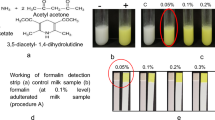Abstract
Vacuum packaged beef strip-loins (fresh and aged) were repackaged on polystyrene trays and over-wrapped with food grade cling film for the storage study. Several volatile compounds such as 3-methyl-1-butanol, 2,3-butanedione, 2-butanone, 3-hydroxy-2-butanone, acetic acid and a few hydrocarbons were detected in the headspace of these tray packaged fresh and aged beef strip loins both in the control and Salmonella typhimurium inoculated samples, in varying concentrations. These compounds were identified using manual headspace solid-phase microextraction (HS-SPME) in combination with gas chromatography/mass spectrometry (GC-MS) over a storage period of 4 days and samples were incubated at 20°C. No naturally occurring Salmonella was present in the control samples. Hexanal (r = 0.99), carbon dioxide (r = 0.98), 3-hydroxy-2-butanone (r = 0.93) and 2-methyl propane (r = 0.95) showed positive correlations with Salmonella population for fresh beef samples. In aged beef samples, 3-methyl-1-butanol (r = 0.99), 3-hydroxy-2-butanone (r = 0.98), carbon dioxide (r = 0.98) and acetic acid (r = 0.86) showed similar trends. In fresh beef samples, F values were significant at p < 0.05 for 3-hydroxy-2-butanone and for carbon dioxide with storage time for fresh beef samples; they were significant for 3-hydroxy-2-butanone, acetic acid and carbon dioxide for aged beef samples.



Similar content being viewed by others
References
Bhattacharjee P, Panigrahi S, Lin D, Logue CM, Sherwood JS, Doetkett C, Marchello M (2010) Study of headspace gases associated with Salmonella contamination of sterile beef in vials using HS-SPME/GC-MS. TASABE 53:173–181
Blackburn CW, Davies AR (1994) Development of antibiotic-resistant strains for the enumeration of foodborne pathogenic bacteria in stored foods. Int J Food Microbiol 24:125–136
Brunton NP, Cronin DA, Monahan FJ (2002) Volatile components associated with freshly cooked and oxidized off-flavors in turkey breast meat. Flavour Frag J 17:327–334
Cadwallader RK, MacLeod AJ (eds) (1998) Instrumental methods for analyzing the flavor of muscle foods. In: Flavor of meat, meat products and seafoods. Blackie Academic and Professional, London, 355–373
Dainty RH (1996) Chemical/biochemical detection of spoilage. Int J Food Microbiol 33:19–33
Elmore JS, Mottram DS, Hierro E (2000) Two-fiber solid-phase microextraction combined with gas chromatography-mass spectrometry for the analysis of volatile aroma compounds in cooked pork. J Chromatogr A 905:233–240
Gianelli MP, Flores M, Toldra F (2002) Optimisation of solid phase microextraction (SPME) for the analysis of volatile compounds in dry-cured ham. J Sci Food Agric 82:1703–1709
Goodridge CF, Beaudry RM, Pestka JJ, Smith DM (2003) Solid phase microextraction-gas chromatography for quantifying headspace hexanal above freeze-dried chicken myofibrils. J Agr Food Chem 51:4185–4190
Kerler J, Grosch W (1996) Odorants contributing to warmed-over flavor (WOF) of refrigerated cooked beef. J Food Sci 61:1271–1274
Luna GR, Diego AL, García-González DL (2006) A tentative characterization of white dry-cured hams from Teruel (Spain) by SPME-GC. Food Chem 97:621–630
Machiels D, Istasse L (2003) Evaluation of two commercial solid-phase microextraction fibers for the analysis of target aroma compounds in cooked beef meat. Talanta 61:529–537
Marco A, Navarro JL, Flores M (2004) Volatile compounds of dry fermented sausages as affected by solid phase microextraction (SPME). Food Chem 84:633–641
Ogihara H, Horimoto Y, Wang ZH, Skura BJ, Nakai S (2000) Solid phase microextraction/gas chromatography of Salmonella-infected beef. J Agr Food Chem 48:2253–2259
Pinho O, Ferreira IMPLVO, Ferreira MA (2002) Solid phase microextraction in combination with GC-MS for quantification of the major volatile free fatty acids in ewe cheese. Anal Chem 74:5199–5204
Ramírez MR, Estévez M, Morcuende D, Cava R (2004) Effect of the type of frying culinary fat on volatile compounds isolated in fried pork loin chops by using SPME-GC-MS. J Agr Food Chem 52:7637–7643
Selby C (2007) Parafilm. Available at http://plant-tc.cfans.umn.edu/listserv/1996/log9612/msg00139.html. Accessed 27 December 2007
Senecal AG, Magnone J, Yeomans W, Powers EM (2002) Rapid detection of pathogenic bacteria by volatile organic compound (VOC) analysis. P SPIE 4575:121–131
Shahidi F (ed) (1998) Flavour of muscle foods: an overview. In: Flavor of meat, meat products and seafoods. Blackie Academic and Professional, London, 1–14
Shang C, Deng C, Zhang X, Chen Z, Hu Y (2002) Headspace solid-phase microextraction and gas chromatography-mass spectrometry analysis of free volatile compounds in mango. Chromatographia 55:737–741
Stanbridge LH, Davies AR (1998) The microbiology of chill-stored meat. In: Davies A, Board R (eds) The microbiology of meat and poultry. Blackie Academic and Professional, London, p 175
Tsigarida E, Nychas GJE (2001) Ecophysiological attributes of a Lactobacillus sp. and a Pseudomonas sp. on sterile beef fillets in relation to storage temperature and film permeability. J Appl Microbiol 90:696–705
Westfall PH, Tobias RD, Rom D, Wolfinger RD, Hochberg Y (1999) Multiple comparisons and multiple tests using the SAS system, SAS institute Inc., p 416
Acknowledgment
The authors would like to express their profound gratitude to the United States Department of Agriculture-Cooperative State Research, Education and Extension Service (USDA-CSREES) for their financial support for this research.
This work was conducted at North Dakota State University, USA.
Author information
Authors and Affiliations
Corresponding author
Additional information
Classification: Muscle Foods
Electronic supplementary material
Below is the link to the electronic supplementary material.
ESM 1
(DOC 757 kb)
Rights and permissions
About this article
Cite this article
Bhattacharjee, P., Panigrahi, S., Lin, D. et al. A comparative qualitative study of the profile of volatile organic compounds associated with Salmonella contamination of packaged aged and fresh beef by HS-SPME/GC-MS. J Food Sci Technol 48, 1–13 (2011). https://doi.org/10.1007/s13197-010-0138-6
Revised:
Accepted:
Published:
Issue Date:
DOI: https://doi.org/10.1007/s13197-010-0138-6




